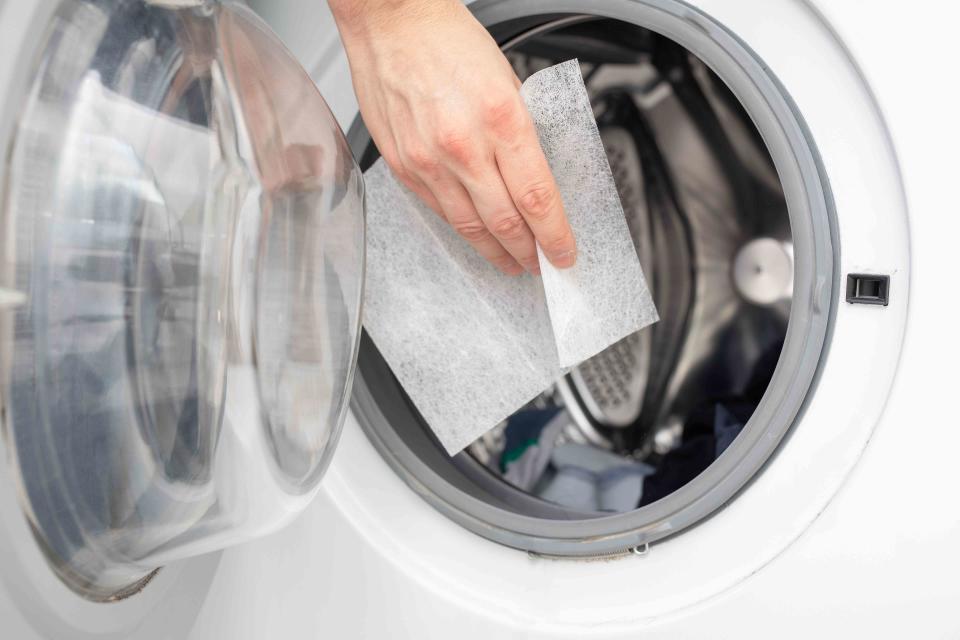What Do Dryer Sheets Do? and Are They Actually Good for Your Laundry?
Here's everything you need to know about these static-nixing superstars.

Wirestock/Getty Images
We spend a lot of time doing laundry in our lives, so we're always looking for ways to streamline the process. There are numerous laundry care products out there that promise to help get the job done more effectively and efficiently. While laundry detergent is an obvious must-have, you might wonder if other add-in products—like dryer sheets—are worth keeping around, or if they're just taking up more time in your routine and consuming more of your budget.
So, we wanted to learn more about dryer sheets, how they work, and if we should really be using them. Here's what laundry pros had to say.
Related:What Does Fabric Softener Do? And Is it Actually Good for Your Clothes?
What Do Dryer Sheets Do?
Dryer sheets are thin, sheet-like pieces of fabric, often made from polyester or cellulose, that are coated with fabric-softening ingredients and fragrances. The first thing you’ll notice about them is that many possess that quintessential “fresh laundry” scent, but dryer sheets do more than simply make your laundry smell nice. They can also help eliminate static electricity, reduce wrinkling, and help your garments and linens feel softer.
“Dryer sheets are designed to be activated by the heat and tumbling action of the dryer,” explains Sammy Wang, a senior scientist for Bounce. “The sheet material tumbles alongside fabrics in the dryer, which then helps to distribute the softening, anti-static, and freshness actives to clothes throughout the load.”
This makes dryer sheets great for fabrics prone to becoming static-y, including wool, polyester, and rayon. They can also help prevent wrinkling in fabrics that become easily wrinkled, such as cotton and linen, while making them feel extra soft to the touch.
Are Dryer Sheets Bad For Clothing?
Since dryer sheets are somewhat of a laundry extra, you might be wondering not only if they're necessary, but also if adding them could be doing any harm to your clothing. We wouldn’t call them bad by any means, but there are certainly best-use cases for dryer sheets. Keep these following considerations in mind before throwing a sheet in your dryer.
They Can Potentially Irritate Sensitive Skin
The static-fighting ingredients and fragrance added to dryer sheets can potentially cause skin irritations for people who are sensitive. “If you or other members of your household have sensitive skin, you might want to do some extra research as dryer sheets may cause irritation,” Leanne Stapf, a cleaning expert and chief operating officer of The Cleaning Authority, says. If it’s the scent that bothers you, check out fragrance-free options.
Don’t Use Them On Water-Repellent Fabrics
Skip dryer sheets when laundering fabrics that wick moisture, such as activewear, microfiber, and absorbent towels. “The ingredients of the dryer sheets will coat the fibers and water will bead off of them, making them non-absorbent,” Jill Koch, a cleaning expert and founder of Jill Comes Clean, says. When in doubt, Stapf says to read your items’ wash care labels to ensure that you are drying your items properly.
Use Them Sparingly
Koch says that, over time, dryer sheets may create buildup and residue on your clothing and coat dryer vents. Use the product as directed, which generally entails using one sheet for a small to average sized load. You can also reduce usage by throwing a dryer sheet into the laundry once every one to two loads.
How To Use Dryer Sheets
Dryer sheets are super easy to use—it’s just a matter of tossing one into the dryer before pressing “start.”
Step 1: Transfer wet clothes to the dryer.
After the washing cycle is complete, transfer everything into the dryer.
Step 2: Add one or two sheets to the dryer.
“While dryer sheets are great for every load of laundry, it’s important to use the right amount of dryer sheets for the size of load you’re drying to make sure you’re getting the full softening, anti-static, and anti-wrinkle benefits for your clothes,” says Wang.
An easy way of gauging how large your load is—and how many dryer sheets to use—is with the ‘armload’ method, Wang adds. If you can scoop up your laundry easily in an armload or less, use one dryer sheet. If your laundry load is a full or overflowing armload, use two.
Step 3: Dry Your Laundry
Finally, let your dryer run a full cycle to reap the benefits of your dryer sheets. You can discard the dryer sheets afterward, since they only provide a single use per sheet.
Alternatives To Dryer Sheets
If you like the benefits that dryer sheets provide, but would prefer an alternative to the single-use laundry product, you’ve got options. One method is to use wool dryer balls (scented or unscented) which provide a similar anti-static, fabric-softening effect.
“Another alternative is to add a half cup of vinegar to the wash cycle to help soften your laundry,” says Koch. “Or, you can try soaking a washcloth or ripped up t-shirt in vinegar and tossing in the dryer with the clothing.” Don't worry, it won't leave your clothes smelling like vinegar!
Related:15 Sustainable Household Product Switches to Make
For more Real Simple news, make sure to sign up for our newsletter!
Read the original article on Real Simple.

 Yahoo Movies
Yahoo Movies 
